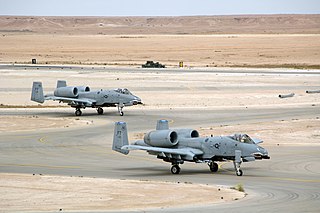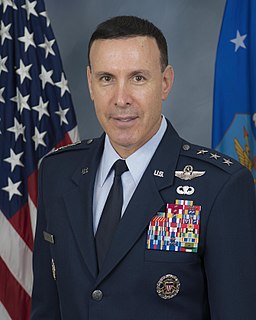
The Afghan Air Force is the aerial warfare branch of the Afghan Armed Forces. It is divided into four wings, with the 1st Wing at Kabul, the 2nd Wing at Kandahar, the 3rd Wing at Shindand, and the 4th Wing at Mazar-i-Sharif in northern Afghanistan. Lt. Gen. Mohammad Dawran serves as Chief of Staff of the Afghan Air Force and Major General Abdul Wahab Wardak is the Afghan Air Force Commander. The command center of the Afghan Air Force is located at Kabul International Airport and the Shindand Air Base in Herat Province serves as the main training area.

The 109th Airlift Wing is a unit of the New York Air National Guard, stationed at Stratton Air National Guard Base, Schenectady, New York. If activated to federal service, the Wing is gained by the United States Air Force Air Mobility Command.

The 321st Air Expeditionary Wing was a United States Air Force unit assigned United States Air Forces Central (USAFCENT), the USAF component command of United States Central Command (USCENTCOM). The unit was reestablished on 1 November 2008 and was a nexus of all Coalition Air Force Training Teams and the Iraqi Air Force at COB Speicher. It was previously the 321st Bombardment Group (Medium), which flew B-25 Mitchells in combat with the Northwest African Strategic Air Force in 1943 and the Mediterranean Allied Tactical Air Force in 1944-45.

The 386th Air Expeditionary Wing is a provisional United States Air Force unit assigned to United States Air Forces Central. As a provisional unit, it may be activated or inactivated at any time. It is currently stationed at Ali Al Salem Air Base, Kuwait in Southwest Asia. During World War II, the group's predecessor unit, the 386th Bombardment Group (Medium) was a B-26 Marauder bombardment group assigned to the Eighth and later Ninth Air Force. During the Battle of Normandy, it supported Allied forces at Caen, and participated in the massive blows against the enemy at Saint-Lô on 25 July 1944. Knocked out targets to help clear the Falaise pocket of German forces in August 1944 and hit strong points at Brest during September.

The 455th Air Expeditionary Wing is a provisional United States Air Force USAFCENT unit located to Bagram Airfield, Afghanistan. It is one of two expeditionary wings in Afghanistan. Most of the wing personnel are located at the Air Force Village known as Camp Cunningham.

The 332d Air Expeditionary Wing is a Provisional Wing of Air Combat Command, currently active. It was last inactivated on 8 May 2012, and most recently reactivated on 19 May 2015.

The 621st Contingency Response Wing is the United States Air Force sole Contingency Response Wing based out of Joint Base McGuire-Dix-Lakehurst, New Jersey.

The 165th Airlift Wing is a unit of the Georgia Air National Guard, stationed at Savannah Air National Guard Base, in the U.S. state of Georgia. If activated to federal service, the Wing is gained by the United States Air Force Air Mobility Command.

The 370th Air Expeditionary Wing (AEW) is a provisional United States Air Force unit assigned to United States Air Forces Central, which may activate or inactivate it at any time. The unit was last stationed in Iraq, and was likely inactivated in 2011 as part of the United States pullout of forces.

The 164th Airlift Squadron is a unit of the Ohio Air National Guard 179th Airlift Wing located at Mansfield Lahm Air National Guard Base, Mansfield, Ohio. The 164th is equipped with the C-130 Hercules.

The 466th Air Expeditionary Group of the United States Air Force provides support for airmen at stations across Afghanistan. This includes "joint expeditionary tasking" airmen, airmen whose units are assigned to a headquarters other than the one from United States Air Force during their deployment. It also includes individual augmentees assigned to joint organizations. The 466th has been headquartered at Al Udeid Air Base, Qatar since 2014, when it moved from the Transit Center at Manas. The group provides a lifeline, referred to as a "Blue Line' back to the Air Force. Its two squadrons, the 466th and 966th Air Expeditionary Squadrons are still located in Afghanistan.

The United States Air Force's 438th Air Expeditionary Advisory Group is a provisional unit assigned to United States Air Forces Central to activate or inactivate as needed. It was last active in Al Anbar province, Iraq to provide close-air support to coalition forces in the region with Fairchild Republic A-10 Thunderbolt II aircraft. It was composed of deployed aircraft, equipment and personnel from Air Force units around the world.
The NATO Training Mission-Afghanistan (NTM-A) activated the NATO Air Training Command-Afghanistan (NATC-A) in September 2010 while simultaneously deactivating its predecessor, the Coalition Air Power Transition Force (CAPTF). This reflected a change from a primarily US led and staffed mission to one that encompassed many other countries within the larger NATO training mission in Afghanistan.
Train Advise Assist Command – Air is a multinational military formation, part of NATO's Resolute Support Mission within Afghanistan.

Steven Michael Shepro is a Lieutenant General in the United States Air Force who currently serves as the 21st Deputy Chairman of the North Atlantic Treaty Organization Military Committee. He assists the Chairman's role as principal adviser to the NATO Secretary General and senior military spokesman of the 29-nation alliance. He also advises the Deputy Secretary General, leads coordination of nuclear, biological and chemical matters, and, in the chairman's absence, directs daily operations and the business of the Military Committee, NATO's highest military authority.
















